Flying-foxes (large bats)
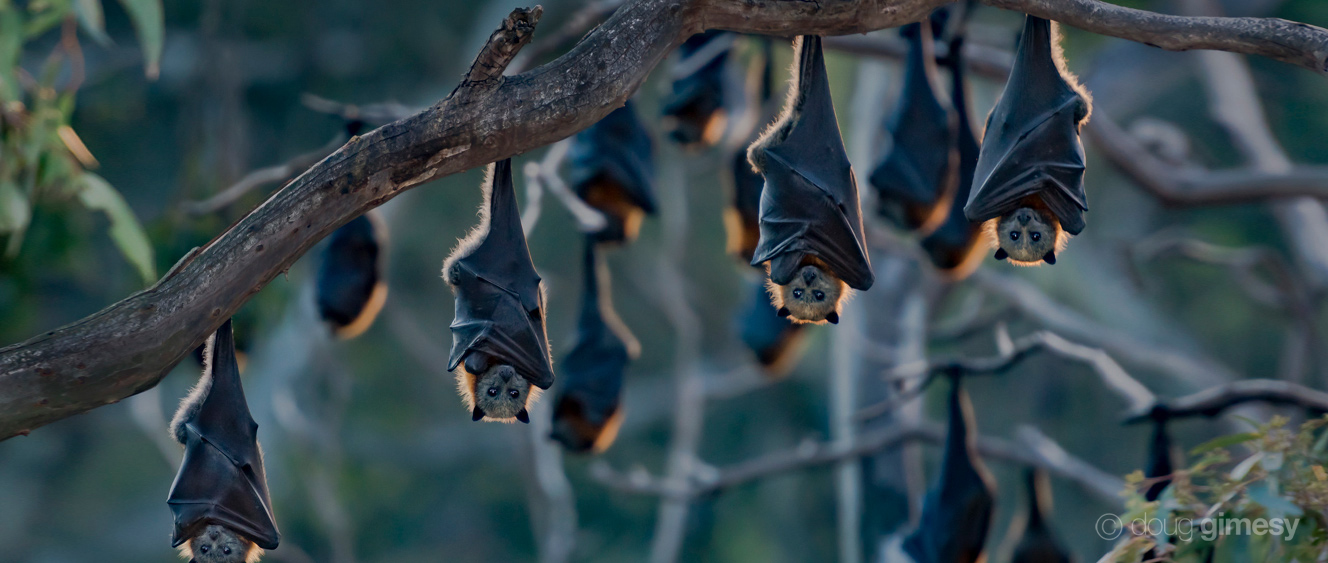
Bats (Order Chiroptera) evolved approximately 56 million years ago and they inhabit all continents with the exception of Antarctica. They make up approximately 25% of all living mammalian species on the planet and are the second most diverse order of mammals after rodents. Through evolution they have diversified into more than 1,232 extant species consisting of 19 different families and they exhibit immense physiological and ecological diversity. Bats uniqueness is a result of being the only mammals adapted for active and sustained flight. The species are of tremendous global importance due to their vital roles as pollinators of respective ecosystems, seed dispersers, insect predators and bio-indicators.
Species - Classification
The classification of bats has gone through many changes in the last decade due the development of new genetic analysis techniques. The once traditionally known suborders (Megabats and Microbats) divided by philological characteristics have been reclassified to include the genetic relationships between the families rather than physiological differences. The suborders are now known as Yinpterochiroptera and Yangochiroptera.
Of the 77 species found in Australia, eight are still commonly known as megabats (Suborder: Yinpterochiroptera, family: Pteropodidae) or more commonly referred to as fruit bats or flying-foxes. Flying-foxes are most commonly found in coastal areas and inhabit and maintain melaleuca and casuarina swamp, mangroves, heathland, dry and wet eucalypt forest, woodland and rainforest ecosystems. Little red flying-foxes are the only flying-fox species which can also be found further inland in arid and semi-arid areas.
The following are the four main species found on mainland Australia.
Black flying-fox (Pteropus alecto)
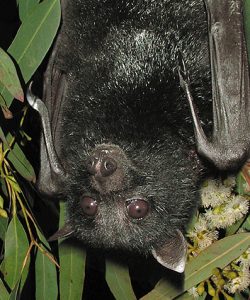
- Status: Least Concern in Queensland
- Description: Mostly all black with a mantle of dark reddish to brown fur on back of neck and shoulders, they have no fur on their legs. Adults weight from about 500 grams to 1 kilogram and can have wingspan up to one metre.
- Distribution: Found in coastal and near coastal areas of northern Australia from Shark Bay in Western Australia to Lismore in New South Wales. They are also found in New Guinea and Indonesia.
Grey- Headed Flying-fox (Pteropus poliocephalus)
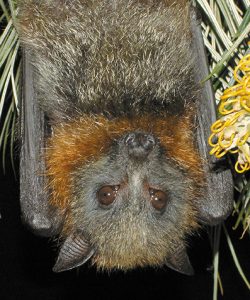
- Status: Nationally listed as Vulnerable to extinction but listed as Least Concerned in the state of Queensland.
- Description: Grey with a ruff of golden fur that completely encircles the neck, only species of flying-fox with hairy legs to ankle. Adults weight from about 500 grams to 1 kilogram and can have wingspan up to one meter.
- Distribution: Found along the south-east coast of Australia, from Rockhampton in central Queensland through to New South Wales to western Victoria and Adelaide. During winter months South East Queensland experience an influx of greys due to the winter flowering. They are the only flying-fox species endemic to Australia, which means if they become extinct in Australia they will be lost forever.
Spectacled Flying-fox (Pteropus conspicillatus)
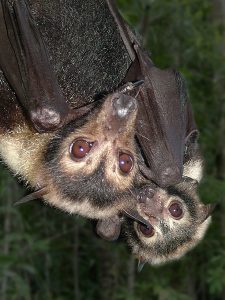
- Status: Nationally listed as Endangered but listed as Vulnerable to extinction in the state of Queensland.
- Description: Mostly all black with a mantle of blondish to light brown fur on the back of the neck and shoulders and around the eyes which gives them the appearance of wearing spectacles, they have no fur on their legs. Adults weight from about 500 grams to 1 kilogram and can have wingspan up to one metre.
- Distribution: Found in the tropical rainforests of North-Eastern Queensland, between Ingham and Cooktown, and between the McIlwrait and Iron Ranges of Cape York. They can also be found on Torres Strait islands. The largest population of Spectacled’s in Australia is located from the Wet Tropics of Queensland World Heritage Area between Townsville and Cooktown.
Little Red Flying-fox (Pteropus scapulatus)
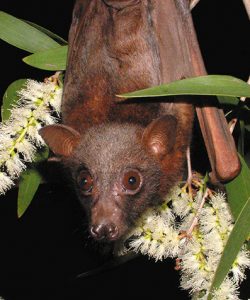
- Status: Least Concern in Queensland
- Description: Are the smallest flying-fox species in Australia weighing between 200 to 600 grams. Their colouring can vary from rusty brown, chocolate brown, light brown, silver and even black and their wings are a reddish brown. Many Little Reds have distinct patches of light cream-brown fur where the wing and shoulder meet.
- Distribution: This common fruit bat has a wide distribution, being found in northern and eastern Australia including Queensland, Northern Territory, Western Australia, New South Wales and Victoria. Common in rainforest and sclerophyll forests and extending inland to semi-arid areas, they prefer to roost together in large bunches closer to the ground than other flying-fox species.
Campsites
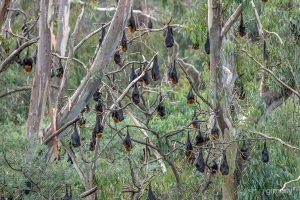 Appropriate habitat which flying-foxes can use for campsites is imperative for the survival of their species as this is where they are born and roost. Campsites may be permanently or temporarily occupied throughout the year depending on the season and food availability. The size of a campsite may also vary during the year, increasing when there is a good food source available within the area or when mothers arrive to give birth to their young. Numbers may also increase if there is little food elsewhere or another campsite has been disturbed or destroyed. A decrease in numbers usually indicates poor food sources in the area or disturbance of a campsite.
Appropriate habitat which flying-foxes can use for campsites is imperative for the survival of their species as this is where they are born and roost. Campsites may be permanently or temporarily occupied throughout the year depending on the season and food availability. The size of a campsite may also vary during the year, increasing when there is a good food source available within the area or when mothers arrive to give birth to their young. Numbers may also increase if there is little food elsewhere or another campsite has been disturbed or destroyed. A decrease in numbers usually indicates poor food sources in the area or disturbance of a campsite.
Campsites are usually located in prime real estate on rivers, creeks or near large bodies of water, which provide both drinking water and a navigation tool used when leaving and returning to camp. Due to accelerating land clearing practices in Australia, flying-foxes no longer have access to the huge undisturbed areas they used to use for large campsites. Colonies are fracturing with smaller colonies springing up in places they have never roosted in before giving the appearance of more flying-foxes when in fact, their numbers are in rapid decline.
Social life of flying-foxes
Flying-foxes are communal animals that form complex hierarchies and social bonds. During the day they roost in campsites ranging from a few individuals to tens of thousands. Little Red flying-foxes are a transient species which follow the seasonal flowering. They can move into a location in such vast numbers that the trees in the roost site sustain significant damage, even causing tree boughs to break under the weight of their bodies.
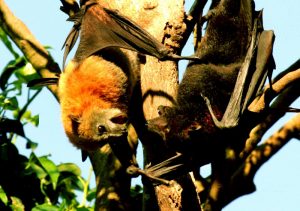 Flying-foxes can be noisy neighbours particularly during mating season and whilst out foraging as they squabble amongst themselves over food resources. These sounds are the language of the flying-fox which use a combination of screeches, chitters and cackles to communicate, the purpose being to establish personal space, roost sites, feeding territories, warding off rivals and mother baby interactions.
Flying-foxes can be noisy neighbours particularly during mating season and whilst out foraging as they squabble amongst themselves over food resources. These sounds are the language of the flying-fox which use a combination of screeches, chitters and cackles to communicate, the purpose being to establish personal space, roost sites, feeding territories, warding off rivals and mother baby interactions.
Family life
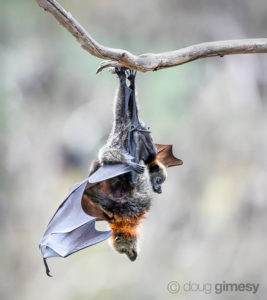 Flying-foxes usually only have one live young per year, which compared to other animals of their size, results in a very low birth rate. Little Red flying-foxes give birth around April/May whilst the remaining three species give birth from September to March each year. Babies are carried by their mothers during her night-time foraging until they are roughly 4 to 5 weeks of age and are too heavy for their mothers to carry. During a baby’s first few weeks of life their survival is fully dependent on clinging to their mother by one of two nipples located in each wing pit and by hanging on with very large feet to their mother’s fur. Once a baby is large enough, they are then left in the colony or the outlying trees of a colony with other babies in what are referred to as crèche trees and wait for their mother to return at dawn. Though it is common for mothers to return periodically through the night to allow the baby to suckle. Young flying-foxes begin to fly at approximately 8 to 10 weeks during which time they start taking short flights in and around the colony whilst still being fully dependent on their mother.
Flying-foxes usually only have one live young per year, which compared to other animals of their size, results in a very low birth rate. Little Red flying-foxes give birth around April/May whilst the remaining three species give birth from September to March each year. Babies are carried by their mothers during her night-time foraging until they are roughly 4 to 5 weeks of age and are too heavy for their mothers to carry. During a baby’s first few weeks of life their survival is fully dependent on clinging to their mother by one of two nipples located in each wing pit and by hanging on with very large feet to their mother’s fur. Once a baby is large enough, they are then left in the colony or the outlying trees of a colony with other babies in what are referred to as crèche trees and wait for their mother to return at dawn. Though it is common for mothers to return periodically through the night to allow the baby to suckle. Young flying-foxes begin to fly at approximately 8 to 10 weeks during which time they start taking short flights in and around the colony whilst still being fully dependent on their mother.
Female flying-foxes start breeding when they are around 15 months old, while males do not become sexually mature until around 3 years of age. During mating season, they form either paired or harem groups and become very noisy as the males’ court females and defend their territory. Males rub secretions from their scent glands on branches to mark their territory.
Feeding habits
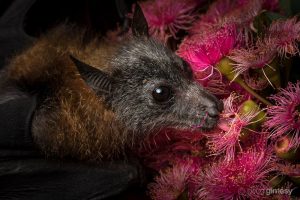 Flying-foxes have developed specialist feeding habits and co-evolved with many Australia native species to be their main vessel for pollination and seed dispersal. They have a very keen sense of smell and excellent eyesight, both of which are needed to locate their food during the night. Their natural food source consists of nectar, pollen and fruit of native Australian forest trees such as eucalypts, Melaleuca, Banksia, lily pilly and Moreton bay figs. Although they do consume cultivated fruit such as peaches, mangoes and pawpaw, they do so only when their native food is scarce, which has become a more common occurrence due to land clearing and destructive bushfires.
Flying-foxes have developed specialist feeding habits and co-evolved with many Australia native species to be their main vessel for pollination and seed dispersal. They have a very keen sense of smell and excellent eyesight, both of which are needed to locate their food during the night. Their natural food source consists of nectar, pollen and fruit of native Australian forest trees such as eucalypts, Melaleuca, Banksia, lily pilly and Moreton bay figs. Although they do consume cultivated fruit such as peaches, mangoes and pawpaw, they do so only when their native food is scarce, which has become a more common occurrence due to land clearing and destructive bushfires.
Flying-foxes generally migrate from one area to another depending on the amount of food available. Unfortunately, with land clearing for agriculture and urban development, forests are being felled at an alarming rate resulting in less pollen, nectar and native fruit for flying-foxes.
Role in our environment
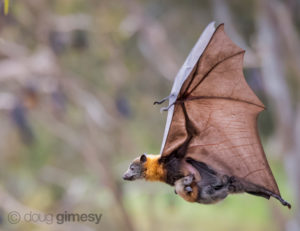 Flying-foxes are of tremendous global importance due to their vital roles as pollinators of respective ecosystems, seed dispersers, and bio-indicators. Their unique ability to regenerate forest from previously cleared or burnt land provide Australia’s natural ecosystems a secret weapon against climate change.
Flying-foxes are of tremendous global importance due to their vital roles as pollinators of respective ecosystems, seed dispersers, and bio-indicators. Their unique ability to regenerate forest from previously cleared or burnt land provide Australia’s natural ecosystems a secret weapon against climate change.
To learn more about their role and their incredible importance click here.
Conservation
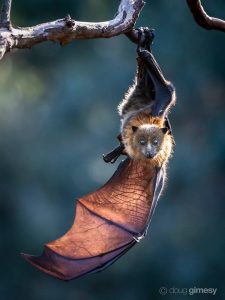 All four mainland species of flying-fox populations are in rapid decline and their numbers have decreased dramatically over the past 60 years due to many factors including habitat destruction, colony dispersals and more frequent and severe weather events including heat waves and drought. . With changes in climatic conditions, Australia is seeing native forests flowering at different times, flowering with no nectar production or not flowering at all. Additionally, heat events where temperatures rise over 41°C are wiping out thousands of bats in a single day.
All four mainland species of flying-fox populations are in rapid decline and their numbers have decreased dramatically over the past 60 years due to many factors including habitat destruction, colony dispersals and more frequent and severe weather events including heat waves and drought. . With changes in climatic conditions, Australia is seeing native forests flowering at different times, flowering with no nectar production or not flowering at all. Additionally, heat events where temperatures rise over 41°C are wiping out thousands of bats in a single day.
The future of Australia’s flying-foxes is looking bleak with very little government protection at Federal and State levels as well as increasing pressure on roost sites due to amenity issues with residents and a growing human population that choose to live in what was traditional flying-fox roosting and feeding habitat.
Flying-foxes are Australia’s secret weapon against climate change as they have the ability to disperse the seeds of regeneration in previously cleared or burnt land. This fact alone should be enough to ensure their future but their decline continues.
Our threats page explains in detail how flying-foxes are being wiped out in Australia and offers suggestions on how people can help. Most importantly, we need Government legislation to change with a focus on climate change, reducing land clearing and revegetating previously forested land.
A positive public perception is also important to help ensure a future for bats as without them, Australia’s ecosystem will no longer contain the wonderful diversity we currently enjoy.


